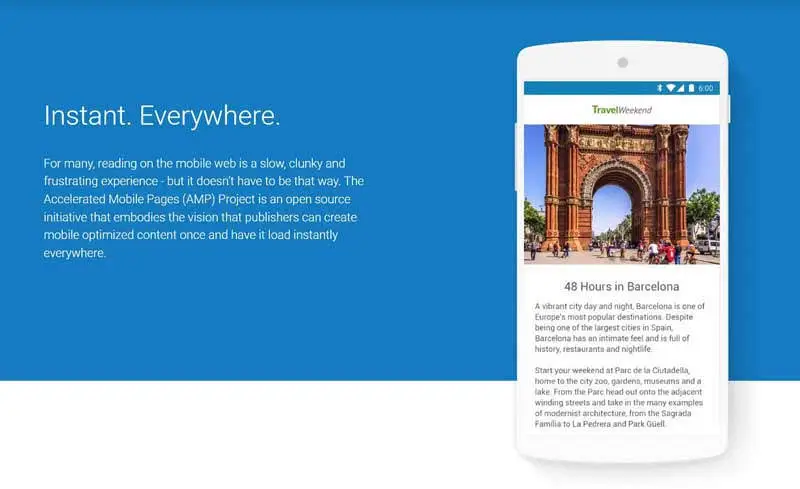Google AMP has been met with scepticism from the beginning. Many of the opinion that the project was simply a response to Facebook Instant Articles and Apple News. Some developers consider the AMP optimization measures too extreme.
Additionally, users worried that AMP gave Google too much control over the web and its content. However, Google insisted that using its in-house tool does not affect your site’s rankings.
In 2021, Google finally made it official. Google’s documentation now states that:
While AMP itself isn’t a ranking factor, speed is a ranking factor for Google Search. Google Search applies the same standard to all pages, regardless of the technology used to build the page.
Google Search Central
Many WordPress site owners have been hesitant to adopt Google AMP since the beginning and, fortunately, this project is no longer as important as it once was.
If you were undecided about implementing AMP, the latest updates from Google may dissuade you from using the AMP project’s components on your website. If, however, you’re not persuaded by other optimization tools or you run a news site, you may want to keep using Google AMP in 2023.
As part of its page experience update, there have been some changes to Google News. Google says: “using the AMP format is no longer required“, and any page is eligible for its Top stories carousel.
I recommend prioritising your Core Web Vitals scores. As long as you do that, your pages should be just as likely to rank well as AMP-optimized ones. Having said that, if you run a news site, you might want to continue using AMP for the time being

Figures from Google show that 40 per cent of mobile phone users will leave a page if it does not load within 3 seconds. To overcome this Google has created an open-source technology AMP. By using this new technique it is possible to provide online news and content rapidly on mobile devices. Google wants to ensure that page load speed is increased on mobile devices, without making it difficult for web designers.

Initially, Google only launched new websites, but they have already announced at the “Hangout” of January 22, 2016, that they will include AMP versions of TravelPilot and retail websites in their search results.
Google announced the start of the mobile AMP project In October 2015. They stated that AMP would be recognised in late February of 2016 in the mobile search results. Publishers were given the opportunity to optimise their websites immediately.
AMP stands for Accelerated Mobile Pages. Implementing AMP straight away, particularly for news providers, means news rapidly appears on mobile devices.
AMP uses the ‘Less is more’ principle as it replaces elements that cause delays in the delivery of data with custom AMP elements in order to facilitate rapid download speeds. Cascading Style Sheets (CSS) are also converted to AMP on AMP pages. When using (external) JavaScript and iFrames are not converted automatically but are included in an AMP release. iFrames can only be used if they are loaded asynchronously, not sequentially as they normally would be, but separately and at the same time. AMP is actually a page, with a stripped-down version of the usual Hyper Text Markup Language (HTML).
Google has also already stated that they will cache AMP in a similar way to a content delivery network (CDN). The pages will, therefore, be delivered from a server as close as possible to the receiver further improving the page loading speed.
All is well and good if you want to read something, of course, but the downside is that the use of AMP suddenly removes some of the adverts. This is because the ads slow down page loading and advertisements are not included in the AMP. Google, therefore, offers the ability to do something to remedy this, by advertisements made in Javascript being converted to an IFrame so that it loads the page in a new window. AdSense and DoubleClick are already supported by AMP.
AMP’s primary goal is to ensure that the mobile network works better and faster and that is great for the users of the mobile networks. For internet agencies, web designers, publishers, advertisers and of course search engine optimisers there is work to meet the AMP criteria.
Those with new sites have the most to gain in adopting AMP for the website and this has already begun. Retail and travel websites will convert later because of the amount of work to reach compliance.
Publishers who work with the Drupal content management system (CMS) can expect a module that will ensure that AMP pages can be generated and AMD technology is already integrated as standard in the WordPress CMS! The WordPress team has followed the AMP project closely and worked on its own implementation of AMP. From today, a website on WordPress.com will automatically support AMP – you don’t have to do anything. Self-hosted WordPress websites can also turn AMP on by installing two plugins ( AMP PLUGIN and PAGE FROG PLUGIN).
For those without a CMS or a CMS that has no plug-in available, then they will have to set to work, using their knowledge of HTML and CSS. Google has a comprehensive manual available that for most people with any HTML knowledge is easy to understand. Converted or new pages can be tested for compliance with AMP using the Web Developers Tool in Google Chrome.
Google states that maximum use should be made of structured data. When an article is written, it must be declared via JSON-LD metadata and can be tested using the Structured Data Testing Tool.
It is not mandatory that the whole website has to be AMP compliant because just as an AMP page can be placed in a link it is also possible to link to another (not AMP) page on the same site, for example, to make a booking or use a contact form.
If an AMP version is made of a page it must always refer to a canonical tag to the original version, because Google indexes it and it is cached.
Advertisers:
The following advertising networks already support AMP:
Google has announced that this list will be constantly updated yet and the current list can be found in the overview of the AMP project.
Google Analytics and other analytics software can simply be used within AMP.
With Google launching Accelerated Mobile Pages in its mobile search results, search engine optimisers around the world are working hard to try as hard as possible to benefit from this change. It is not clear yet whether AMP will eventually be a ranking factor for mobile searches. At the moment it is certain that the results obtained through AMP will ensure that they are presented at the top of the carousel (or at the top of Google anyway). This saves, as mentioned earlier, most likely a lot of organic traffic.
It is clear that Google’s AMP project has stirred up a lot of dust in its quest to please mobile internet users. The creators of news websites, in particular, need hard work to keep up with the competition and stay ahead if possible. For others, there is still time but it looks as though they may also need to be AMP-compliant very soon.
You can see what this page looks like in AMP format by clicking here (Accelerated Mobile Pages – amp mobile)